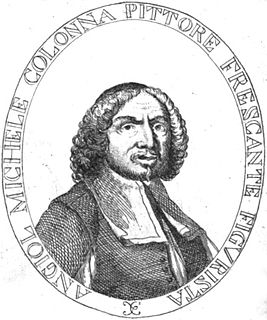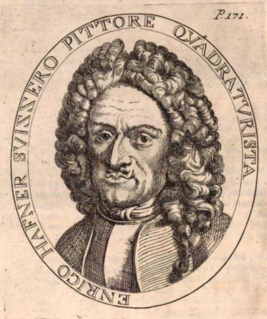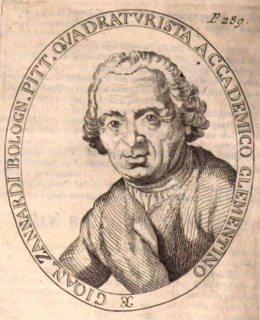Related Research Articles

The Basilica of San Petronio is a minor basilica and church of the Archdiocese of Bologna located in Bologna, Emilia Romagna, northern Italy. It dominates Piazza Maggiore. The basilica is dedicated to the patron saint of the city, Saint Petronius, who was the bishop of Bologna in the fifth century. Construction began in 1390 and its main facade has remained unfinished since. The building was transferred from the city to the diocese in 1929; the basilica was finally consecrated in 1954. It has been the seat of the relics of Bologna's patron saint only since 2000; until then they were preserved in the Santo Stefano church of Bologna.

Marcantonio Franceschini was an Italian painter of the Baroque period, active mostly in his native Bologna. He was the father and teacher of Giacomo Franceschini.
Giovanni Gioseffo dal Sole was an Italian painter and engraver from Bologna, active in the late-Baroque period. Upon the death of Carlo Cignani, Gioseffo dal Sole became among the most prominent painters in Bologna, described as the Guido Moderno.

Giuseppe Bartolomeo Chiari, also known simply as Giuseppe Chiari, was an Italian painter of the late-Baroque period, active mostly in Rome.

Giacomo Boni was an Italian painter of the late-Baroque period, active mainly in Genoa.

Angelo Michele Colonna was an Italian painter of the Baroque period, active in Bologna, northern and central Italy and Spain. He is sometimes referred to as Michelangelo Colonna.

Giuseppe Pedretti was an Italian painter of the late-Baroque or Rococo period, active mainly in Bologna.
Giacinto Garofalini (1661–1723) was an Italian painter of the Baroque period, active mainly in Bologna. He was initially a pupil of Donato Creti, then a pupil of the painter Marcantonio Franceschini. Also called Garofolini by Luigi Lanzi. He was an professor at the Accademia Clementina, where he taught figure painting.

Tommaso Aldrovandini was an Italian painter of the Baroque period. He mainly painted perspective views and architectural subjects (quadratura), in which the figures were painted by Marcantonio Franceschini and Carlo Cignani. He decorated churches, palaces, and theaters in Forlì, Verona, Venice, Parma, Turin, Ferrara, and Genoa, and especially in his native Bologna. Among his pupils was Giovanni Benedetto Paolazzi.

Enrico Haffner was an Italian painter of quadratura during the Baroque period, active mainly in Bologna.

San Filippo Neri is a Baroque church on via Lomellini in central Genoa. The order of the Oratory of Saint Philip Neri had arrived in Genoa in 1643, under the sponsorship of the Oratorian and Marchese Camillo Pallavicini who was born in Genoa. Originally housed in the church of San Pancrazio, by 1674 the order began a move to this new site and built their church and chapter house on the site of a former palace of the Lomellino family.
Mauro Aldrovandini (1649–1680) was an Italian painter of the Baroque period. While he was most active in Bologna, and some claim he was native to the city, others claim he was born in Rovigo. He mainly painted perspective views and architectural subjects (quadratura) in private houses and for theaters.
Gaetano Alemani was an Italian painter, active mainly in Bologna in the architectural and ornamental painting (quadratura) for the decoration of churches and theatres, as well as a scenic designer.

Giuseppe Maria Mazza was one of the leading sculptors of Bologna, Italy, in the late 17th and early 18th centuries. He was trained as a painter, but is best known for his fine sculptural work in terracotta and stucco.

Giovanni Zanardi was an Italian painter of quadratura during the late Baroque period.
Jacopo Antonio Mannini or Giacomo Antonio Manini was an Italian painter of the late Baroque period. He mainly painted quadratura.

Stefano Orlandi was an Italian painter, active mainly in Bologna in the architectural perspective painting. He is known for painting fanciful architectural canvases, known as Capricci.

San Giorgio in Poggiale is a Baroque-style, deconsecrated, former Roman Catholic church, now serving as the Art and History Library of Fondazione Carisbo, located on Via Nazario Sauro 20 in central Bologna, Italy.
Alessandro Baratta was an Italian painter and engraver.
Giuseppe Maria Rolli or Roli is an Italian painter and engraver active during the Baroque period, mainly in his native Bologna.
References
- ↑ Archive of Architecture.
- ↑ [Zanotti, Giampietro (1769). Storia Dell'Accademia Clementina Di Bologna, Volume 1. Lellio dalle Volpe, Bologna. pp. 401–403.